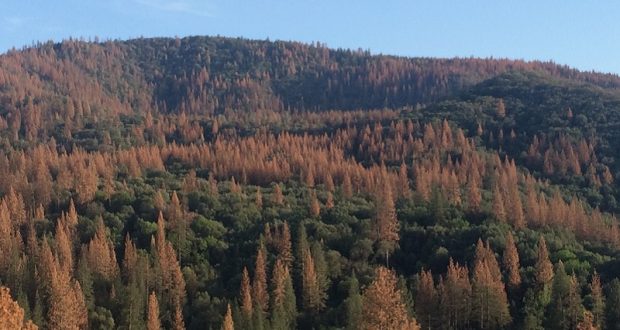SACRAMENTO – Governor Jerry Brown’s $180 billion May revision to the 2017-2018 budget proposes cutting millions of dollars from funding to fight fires and support local tree mortality projects in California’s forestlands.
The Governor’s updated budget, released on Thursday, May 11, cuts funding for the Office of Emergency Services from $52.7 million to $8.5 million, with only $2 million allocated “for local agencies to remove dead or dying trees.”
“This is less than four percent of the funds allotted in January of this year,” says Assemblyman and Budget Committee Member Jim Patterson of California’s 23rd District in a statement released today.
“Cal Fire would also see a huge cut if the Governor’s budget is approved. Funding for the extended fire season, increased firefighter surge capacity, Conservation Corps fire suppression crews, and aerial assets is set to be slashed by nearly half — from $91 million to $41.7 million.
“The drought may be officially over, but the tree mortality crisis is not. Trees are still dying and the need to fund local efforts is greater than ever. Now is not the time to slash and burn these vital programs.”
Richard Bagley, President of the 168 Fire Safe Council believes the drastic cuts threaten to undermine the ongoing work within mountain communities statewide.
“Ignoring the current conditions will make the situation worse and more costly, hopefully not resulting in loss of public lives, or the lives of the firefighters dedicated to trying to protect them,” says Bagley in a statement released by Assemblyman Patterson’s office today.
Patterson is roundly criticizing Governor Brown’s proposed budget cuts, noting that the governor recently declared May 7-13 as “Wildfire Awareness Week” in California.
“His proclamation acknowledged the continuing threat of fires and noted the 423,000 dead trees removed thanks to the work of local Tree Mortality Taskforce groups around the state,” says Patterson. “The Governor is patting himself on the back for creating the Tree Mortality Taskforce while crippling their funding source. Programs that put money in the hands of residents to clear wildfire fuel from their property should be fully funded. The health and safety of our forests, families and fire fighters depends on it.”
Politifact California disagrees with Patterson’s reading of the facts, calling his claims “mostly false.”
“Patterson taps into a real concern over tree mortality and its cost to local governments,” says Chris Nichols in an article posted May 25. “But his statement cites a misleading budget number and ignores critical facts that would give a very different impression.”
To read the entire article on Politifact, click here.
To view the May Revision to the Governor’s Budget 2017-18, click here.





Gina Clugston, I thought reporters were supposed to fact check sources, rather than simply regurgitating misleading press releases from partisan assemblymen like Jim Patterson.
Is Sierra News Online an unbiased news source, or a right-wing propaganda machine?
http://www.politifact.com/california/statements/2017/may/25/jim-patterson/did-jerry-brown-axe-funds-removing-californias-dea/
Tony, we do not generally report on state issues at all; this post was simply notifying our readers that cuts to the state budget in the area of tree mortality may affect them, and give them notice about this issue, so they could follow it if they so desired. We did indeed check the facts on the state budget released by the governor’s office. We do not have the resources for in-dept, investigative reporting on state issues, and must choose between not reporting at all, or reporting that issues affecting our residents are in the news, and allowing people to follow news agencies with far more resources than we have. As for quoting Jim Patterson, some politicians put out press releases and return phone calls, and others do not. We take no side whatsoever on the politics of this, and are happy to put forward other legislators’ responses to this issue as they are made available.
If you’re genuinely interested in being an impartial disseminator of facts, then I suggest you update the article to reflect the well sourced debunking of Patterson’s claims provided by politifact. Worth noting that Firewise Madera is linking to your article & furthering the misinformation campaign. I’d argue it’s your responsibility as the journalist of the piece to do so, in light of subsequently revealed (fact based & clearly sourced) information.
I will be happy to add that Politifact disagrees with Patterson’s assessment, however, the statement from Janet Upton quoted in their article is completely at odds with the information decimated by Cal Fire in the past, which we have reported on. Upton states: “Since the tree crisis started, local governments have requested less than $600,000 from the disaster fund for the removal costs.”
That does not square with the fact that On Dec. 2, 2016, Cal Fire announced “More than $15 million spread across 34 California counties will be used to remove dead and dying trees and thin fuels that could otherwise exacerbate wildfires. Agencies in Mariposa and Madera Counties are the recipients of more than $2 million from those grant disbursements, to be used for the removal of dead and dying trees.” Here is a link to those grants: http://www.fire.ca.gov/Grants/downloads/2017_SRA_TM_GrantAwardees.pdf
It was also noted in that press release that Cal Fire received 264 submittals for grants, but a total of only 107 projects were selected; far more funding was actually requested, but was denied. It goes on to say, “An additional $6 million from the state General Fund supports local efforts to remove dead and dying trees that pose a threat to public health and safety and projects that reduce the wildfire threat to homes.”
Perhaps the confusion generated by Upton’s statement is the word “governments,” which may not include other agencies such as Firewise and Conservation Districts.
I understand that the OES also includes funding for things other than hazard tree removal, but even using Cal Fire’s own figures, a reduction from $15.75 million to $2 million can certainly be seen as a major reduction in funding.